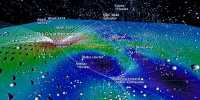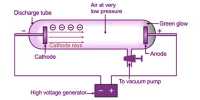For the first time, a weird quantum entity known as a “domain wall” has been generated in a laboratory. Even though there is nothing there, the “wall” between high- and low-density atoms in a quantum state can behave as if it were an object independent of either. Furthermore, the dividing line’s reactions to external pressures may differ from those of the atoms it divides. We may begin to regard the boundary as a thing in itself, an “iron curtain” or “color bar” perhaps, even if there is no physical barrier, when groups of individuals segregate themselves on either side of an imaginary line. This is a mental illusion, possibly similar to pareidolia, in the classical world.
It can, however, be far more real in quantum mechanics. Domain walls, which are borders between separated atoms that act as self-contained quantum objects, have been difficult to consistently create. Now, a team from the University of Chicago has published a paper in Nature claiming to be able to manufacture domain boundaries at whim, and they’ve already discovered some unexpected behavior in their creations. In a release, student and first author of the study Kai-Xuan Yao said, “It’s kind of like a sand dune in the desert — it’s made up of sand, yet the dune acts like an object that behaves differently than individual grains of sand.”
Even if their behavior blurs the lines between solid and wave, sand dunes are genuine objects. We wouldn’t say the same about the dune’s relationship with the air surrounding it. When Yao, Professor Cheng Chin, and co-authors examined the domain wall that separates two sorts of atoms, they discovered that it has its own mind.
“We know that pushing atoms to the right causes them to migrate to the right. However, pushing the domain wall to the right causes it to shift to the left.” Chin remarked. To make matters even worse, the reaction isn’t exactly what you’d expect. Instead, according to the paper: “We discover that the domain walls respond to a synthetic electric field with a charge-to-mass ratio that is greater than and opposite that of naked atoms.”
The domain wall is thus an emergent phenomena, in which numerous particles appear to obey different physical laws while operating collectively than when acting individually. The emergent phenomena, on the other hand, have no actual atoms, only the line between them.
The domain wall was generated within a Bose-Einstein condensate (BEC), a phenomenon in which a large number of atoms together exhibit quantum behavior similar to that of a single subatomic particle. A BEC is made up of 40,000 cesium atoms that have been supercooled.
The BEC was subsequently forced to split into high- and low-density regions, causing electromagnetic fields that resulted in the team’s unexpected domain wall effects. Domain barriers formed between these regions in over 90% of samples, one parallel to the field and the other perpendicular to it, demonstrating the method’s dependability. Along the adjacent wall, vortices formed.
The researchers were able to investigate behavior under a variety of situations, including different quantities of atoms and the amount of externally applied pressure, because the walls formed so dependably. “This phenomenon could have applications,” Chin remarked. “It can be utilized to provide a more reliable method of storing quantum information or to enable novel functionality in materials.” But before we can figure that out, we need to figure out how to govern them.”















